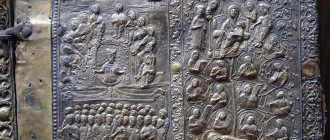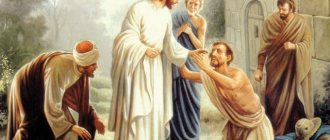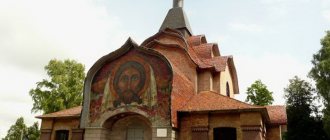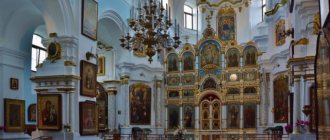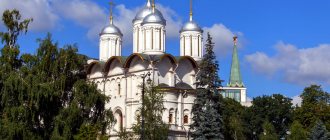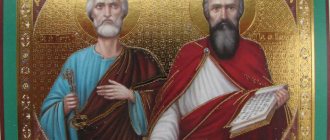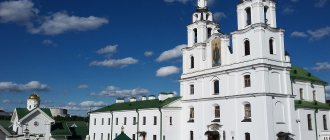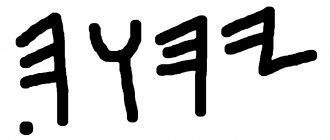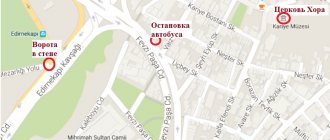The history of the Holy Trinity holiday
According to biblical covenants, it is believed that on this day the prophecy of Christ was to be fulfilled, and the Holy Spirit was to descend to earth. According to Scripture, this was supposed to happen on the tenth day after the soul of Christ ascended, and on the fiftieth after his resurrection.
On this day, in anticipation of a miracle, the Mother of God and the apostles gathered in the upper room at the usual time for prayer. Suddenly they heard a noise, and a holy fire appeared before their eyes, which burned but did not burn. Just at this moment the descent of the Holy Spirit occurred, which signified that they had undergone the baptism of fire and the Holy Spirit.
Over time, a crowd gathered outside the house. People came here from different countries to see the miracle with their own eyes. The apostles began to come out to them and talk to them in their native language. This could not but surprise, since everyone knew that the disciples of Christ were not scientists from Galilee and could not know the languages of other peoples.
The next miracle of this day is considered to be the sermon of the Apostle Peter, who had never preached before, but was only a humble disciple of his Teacher. But when he spoke, it became clear to everyone around him that the Holy Spirit Himself was speaking through his lips. The sermon was so heartfelt that many who listened to it believed in Christ and received Baptism on the same day.
The Day of the Descent of the Holy Spirit on the Apostles is considered the birthday of the Church. From now on, more and more people began to come to the prayer service of the apostles and listen to their sermons. And over time, the place of the Descent of the Holy Spirit on the apostles began to be considered sacred, where everyone can pray.
Pentecost icon
Vasilyeva A.V.
History of the holiday
The Feast of Pentecost commemorates the event of the descent of the Holy Spirit on the apostles in the form of tongues of fire, that great day when the birth of the universal apostolic Church of Christ took place (Acts II: 41-47). This holiday received the very name Pentecost because the descent of the Holy Spirit took place on the Old Testament holiday of Pentecost, which was celebrated on the fiftieth day after the Jewish Passover.
The descent of the Holy Spirit on the apostles on the day of Pentecost is described in the Acts of the Holy Apostles (Acts II: 1-18). On the fiftieth day after the Resurrection of Christ, the apostles were in the Zion Upper Room in Jerusalem, when «…
suddenly a noise came from the sky, as if from a rushing strong wind, and filled the whole house where they were.
And cloven tongues as of fire appeared to them, and one rested on each of them. And they were all filled with the Holy Spirit, and began to speak in other tongues, as the Spirit gave them utterance ”
(Acts II: 2-4).
On this day in the city, on the occasion of the holiday, there were many Jews from different cities, who, hearing the noise in the house and what was being said inside in various dialects, began to mock the apostles and say that they were drunk with sweet wine (Acts II: 13) . As the book of the Acts of the Apostles tells us, in response to this «
Peter, standing with the eleven, lifted up his voice and cried out to them: Men of the Jews, and all who live in Jerusalem!
Let this be known to you, and listen to my words: they are not drunk, as you think, for it is now the third hour of the day; but this is what was foretold by the prophet Joel: And it shall come to pass in the last days, says God, that I will pour out My Spirit on all flesh, and your sons and your daughters shall prophesy; and your young men will see visions, and your old men will dream dreams. And on My servants and on My handmaids in those days I will pour out My Spirit, and they will prophesy ”
(Acts II:14-18).
Among the Jews who came to the house there were those who listened to the apostolic sermon and asked what they should do. To this, the Apostle Peter replied that they needed to repent and be baptized in the name of Jesus Christ for the forgiveness of sins in order to also receive the gift of the Holy Spirit. There were about three thousand people who believed in Christ and willingly accepted baptism in the first days after the descent of the Holy Spirit on the apostles. This marked the beginning of the establishment of the Church of Christ on earth.
The apostles commanded the very day of the Descent of the Holy Spirit to be remembered and celebrated annually by all Christians (1 Cor. xvi, 8), (Acts xx, 16).
Establishment of a holiday
The Feast of Pentecost in the Old Testament was celebrated in memory of the giving of the Sinai legislation, the solemn entry of God into a covenant with the chosen people, and at the same time in gratitude to God for the production of new fruits of the earth (Num. 28, 26) and a new harvest (Ex. 23, 16). It was celebrated after the completion of seven weeks, that is, on the fiftieth day after Easter, and was called the Feast of Weeks (Deut. 16:9-10). By God's providence, according to the promise of the Savior (John 14:26), on this day of remembrance of the giving of the revealed law and on the fiftieth day after the Resurrection of Christ, the Descent of the Holy Spirit took place on His apostles and disciples. This event marked the entry of God into the New Testament with the New Israel - the Church of Christ, and the place of the law of Sinai was replaced by the grace of the Holy Spirit.
In the first centuries of Christianity, the holiday of Pentecost was understood as an entire period of the church year, which also included the Ascension of the Lord [1]. In the 4th century, Pentecost finally took shape not only as a special period after Easter, but also as a single holiday [2]. Following the Descent of the Holy Spirit, the Ascension of the Lord was also highlighted on a special holiday [3].
In the 4th century, Saint Basil the Great composed special prayers that are read to this day at Great Vespers, which is celebrated immediately after the liturgy on the very day of the holiday. At this service, which is one of the most solemn and beautiful services of the year, stichera are sung glorifying the descent of the Holy Spirit, and three lengthy prayers are read for the Church, for the salvation of all Christians and for the repose of the souls of the departed (including those “those held in hell” ). While reading these prayers, all worshipers are on their knees, which ends the post-Easter period, during which no kneeling or prostration is performed in churches.
The spiritual meaning of the holiday
The Feast of Pentecost, or the Descent of the Holy Spirit, has another name that most reflects the spiritual essence of this event. This holiday is also called the Day of the Holy Trinity, which indicates the participation of all Three Persons of the Divine in accomplishing the salvation of the human race. In other words, through the Descent of the Holy Spirit, the Divine Economy reached its perfect completeness: “God the Father creates the world, God the Son redeems people from slavery to the devil, God the Holy Spirit sanctifies the world through the dispensation of the Church.”
The descent of the Holy Spirit on the apostles is an event of paramount importance also because it miraculously confirmed the Sacrament of the Priesthood. For example, in the works of St. Simeon the New Theologian, the continuity of apostolic succession in the transmission of the Gifts of the Holy Spirit to the church hierarchy is emphasized: “The apostles, going out into the world, taught, preaching the word of God. Large crowds believed in Christ, and churches of the faithful were founded in cities and towns. When one of the apostles was about to leave them and go to another place or city, he ordained bishops and elders in his place... And these, ending their lives in turn, left others in their place, choosing persons worthy of such service, and whom they ordained . And thus, by succession, such order and legislation have been preserved to this day by the action of the Holy Spirit. In the same way, the traditions of the apostles and their teachings, as they received them from our Master and God of all, were transmitted by them to us.”
The descent of the Holy Spirit on the apostles was a manifestation of His power in them, the discovery of His special presence in the disciples of Christ. The Holy Spirit came to complete what was begun by the Savior - to make the apostles capable of preaching the Gospel to the whole world, to assimilate to the human race those Divine gifts that were acquired for it by the suffering of the Son of God. Thus, thanks to the event of the Descent of the Holy Spirit, man received the opportunity to see God, to participate in the gracious Kingdom of the Father and the Son and the Holy Spirit. From the outside, the celebration of Pentecost, namely the decoration of churches and houses with green branches, herbs and flowers, inherited from the Old Testament Church, symbolically expresses the power of the Holy Spirit, reviving, renewing and giving life and flourishing to everything.
Iconography
Like the image of the Ascension of the Lord, the iconography of Pentecost in Byzantine and Old Russian art is presented in two versions. Both options developed in the early Christian era and were continued in easel icon painting, as well as mosaics and fresco painting of Byzantium and Rus'.
Since the dogma of the Trinity is one of the main theological ideas revealed in the feast of Pentecost, the image of the Holy Trinity was adopted to depict this event in iconography from early Christian times. The image of the Holy Trinity in the form of three wanderers, or angels, who appeared to the forefather Abraham at the oak of Mamre, conveys the first appearance of God to man, marking the beginning of the promise of redemption, which was fully completed on the day of the descent of the Holy Spirit on the apostles. This version was called the “Old Testament Trinity.”
The oldest examples of the iconography of the “Old Testament Trinity”, or otherwise “Hospitality of Abraham”, include a fresco in the Via Latina catacomb of the 4th century, as well as a mosaic of the first half of the 6th century, which is located in the altar of the Church of St. Vitaly in Ravenna. In the post-iconoclastic period, this plot became widespread in Byzantium. In Rus', similar images have appeared since the 11th century - an example is the fresco of the St. Sophia Cathedral in Kyiv.
The angels depicted in the composition are arranged according to the principle of isokephaly, that is, sitting next to each other at the table as equal in dignity to each other, which emphasizes the equality of the Hypostases of the Holy Trinity when they are not merged [4]. The most perfect example of this type of iconography of the Holy Trinity is the famous image painted by St. Andrei Rublev in 1425-1427.
Characteristic features of the composition “Abraham’s Hospitality” may also include images of Abraham, Sarah and servants slaughtering a sacrificial calf. On some of the depictions there are no images of servants, but the forefathers Abraham and Sarah are depicted among the Angels, behind their backs.
If the image of the “Old Testament Trinity” gives an indication of the mystery of divine existence, then the icon of the Descent of the Holy Spirit reveals the providential action of the Holy Trinity in relation to the Church and the world.
The development of the iconography of the “Descent of the Holy Spirit” begins in the 6th century, its images appear in the facial Gospels (Gospel of Rabula), mosaics and frescoes. One of the earliest surviving depictions of the Descent of the Holy Spirit, a handwritten Gospel created in 586 by the Syrian monk Rabula (Laurentian Library, Florence), contains a miniature depicting the event. In the center of the composition is the Mother of God, flanked by twelve apostles in two rows under the arches of the triclinium. Directly above the Mother of God, a dove is depicted rapidly flying down, which is an image of the Holy Spirit, from which shining rays are poured onto the head of the Mother of God. Red flames burn above the heads of the Virgin Mary and the apostles.
On the Sinai icons of the Descent of the Holy Spirit of the 7th–9th centuries, dating back to the most ancient examples, the seated apostles receive the Holy Spirit in the form of descending rays of flame from the Savior blessing them from heaven.
In the St. Sophia Cathedral of Constantinople, the mosaic image of the Descent of the Holy Spirit on the Apostles (9th century) has in the center of the composition a prepared Throne (Etimasia), below which, in a circle, there are standing apostles, on whose heads rays with tongues of flame descend, and even lower are located symmetrically arranged groups of people in various clothes - the future flock of the nascent Church of Christ. This version of the iconography of Pentecost found its continuation in the mosaic temple art of the 11th-13th centuries, becoming the central composition of the dome painting (mosaics of the Cathedral of Osias Lucas in Phocis, St. Mark's in Venice).
In easel painting, the compositional scheme of this iconography of Pentecost is distinguished by details that give the image various shades of theological content.
Traditionally, icons of the Descent of the Holy Spirit on the Apostles represent the Upper Room of Zion, in which, according to the Book of the Apostolic Acts, the Apostles gathered. Books, scrolls are placed in their hands, or a blessing gesture is given to their fingers, and descending flames are written over the heads. The place of Judas Iscariot among the 12 disciples of Christ was taken by the Apostle Matthias.
In most Pentecost icons dating back to the 16th century, in the upper part of the composition, among the apostles, there is an image of the Virgin Mary. The basis for such iconography is the mention in the New Testament of the presence of the Mother of God in the Upper Room of Zion during joint apostolic prayers: «
they all continued with one accord in prayer and supplication, with some of the women and Mary, the Mother of Jesus, and with His brothers
” (
Acts I, 14).
The apostles, as a rule, in this composition are arranged in a horseshoe shape of six disciples on the left and right, with the empty space between the central figures of the apostles Peter and Paul reminiscent of the presence of the Lord Jesus Christ, as can be seen in the icons of the Last Supper [5].
In the lower part of the icon, in the dark space that is the center of the triclinium or truncated ellipse, the figure of the king can be placed, replacing the image of crowds of people from different countries who witnessed the descent of the Holy Spirit [6]. The traditional interpretation of the image of the king is the image of the people to whom the gospel sermon is addressed, represented by a single figure of its ruler. In his hands the king holds a stretched veil (ubrus), on which 12 scrolls are laid, which are a symbol of the apostolic sermon. In connection with this interpretation, next to the figure of the king, the Greek inscription κόσμος - “world” began to be placed, thanks to which the image of the king itself received the name “Tsar-Cosmos” [7]. This feature belongs to later Greek and Russian monuments belonging to the 15th–18th centuries.
The peculiar contrast of the event of the Descent of the Holy Spirit on the apostles with the image of the king of the cosmos suggests that the upper room where the apostles sit is understood as a temple that should coincide with the entire universe and reveal a new world and a new kingdom, where peace and joy in the Holy Spirit will reign.
Notes
1. For example, Tertullian calls this time “laetissimum spatium”, i.e. a most joyful period (Tertull. De orat. 23).
2. This decree is reflected in the 43rd rule of the Council of Elvira (300).
3. By the 4th century. the celebration of Pentecost became widespread, as evidenced by its mention in the works of Saints Eusebius of Caesarea, Basil the Great, Gregory the Theologian, Gregory of Nyssa, Epiphanius of Cyprus, John Chrysostom, and Blessed Augustine. There is a legend that the first Christian church was built at the site of the descent of the Holy Spirit, which was rebuilt by Queen Helen, Equal-to-the-Apostles, in the 4th century.
4. For example, in the mosaic of St. Mary the Great in Rome, 5th century, or in the Cotton Bible, of the same time, in the British Museum in London. In addition, the equality of the Hypostases in some images is emphasized by the same color clothes of the angels and their attributes (mosaic of St. Vitaly in Ravenna, 6th century). In other cases, the composition is built pyramidally, highlighting the middle angel as the main one among the others.
5. Although, according to the book of Acts, the Apostle Paul, then Saul, the persecutor of Christians who had not yet been converted to the faith, was not present in the Zion Upper Room, he is traditionally depicted on the icon of the Descent of the Holy Spirit. This is explained by the fact that the icon does not show a chronologically correct historical evidence of the holiday, but its spiritual essence. The descent of the Holy Spirit on the apostles is understood here as the beginning of the Christian Church, uniting all believers - both living and those who have departed from earthly life. Therefore, the appearance on the icon of the holiday of the Apostle Paul, the herald of the word of God, without whom the creation and triumph of the Christian Church would have been unthinkable, is quite justified.
6. In ancient Byzantine examples, the crowd of people located at the bottom of the image of Pentecost is often accompanied by the inscription “Tribes, Gentiles.” Sometimes the figure of a king and black people are introduced into it, while in Armenian-Georgian manuscripts you can see people with dog heads (Etchmiadzin manuscript of the 13th century).
7. Despite the inscription, the meaning of the figure of the king still causes different interpretations by researchers. Thus, according to one assumption, the prophet Joel was originally depicted here, whose image was allegedly distorted over time by later icon painters, who turned the prophet into a king. In support of this opinion, the prophecy itself, placed in Acts, was cited: I will pour out My Spirit on all flesh, and your sons and your daughters will prophesy; Your old men will dream dreams, and your young men will see visions, and also on male and female servants in those days I will pour out My Spirit (Joel 2:28-29). This explanation was given by some Athonite monks who did not trust the competence of the icon painters and interpreted this image according to their own considerations, despite the inscription “Cosmos”. There is an interpretation of this image also as King David, whose prophecy about the resurrection of Christ was quoted by the Apostle Peter in his sermon (Acts II) and whose grave is believed to be located on the first floor under the Zion upper room. Less common is the interpretation of the figure of the king as an image of Jesus Christ in the image of the Old Denmi, who remains with his disciples until the end of the age.
Troparion, tone 8
Blessed are you, Christ our God, / who are wise fishers of phenomena, / sending down the Holy Spirit to them, / and with them you caught the universe, // Lover of mankind, glory to you.
Kontakion, tone 8
When the merging tongues descended, / dividing the tongues of the Most High, / when the fiery tongues were distributed, / we called everything into unity, // and accordingly we glorified the All-Holy Spirit.
Greatness
We magnify Thee, / Life-giving Christ, / and honor Thy All-Holy Spirit, / Whom Thou didst send from the Father, / as Thy divine disciple.
© All rights reserved
How Baptism by Fire Changed the Apostles' Lives
After this day, the disciples of Christ changed very much. Until that day, they fell into despair and gave in to despondency, because they could not survive the death of their Teacher. Not everyone believed that the Son of God would resurrect and come to earth in a different guise, although He told them about this more than once. But the descent of the Holy Spirit on the apostles changed them dramatically. They became preachers of the Word of God who no longer betrayed their faith.
They believed, even though they knew about all the torments they would have to endure. As Christ prophesied to them, their lives would be given over to persecution, they would be ridiculed and slung with mud. Some were locked up in prison and mocked, just to “knock out” the faith from their souls and stop the endless chain of sermons. So that the burden of the apostles would not be so heavy, Christ sent His disciples the Comforter Spirit, who supported their faith and helped them endure all the hardships associated with persecution.
From now on, no one and nothing could make the apostles doubt their faith. Even during executions, beatings, and crucifixions, the spirit of Christ’s disciples became increasingly stronger.
The first Christians lived righteously, keeping all the commandments and following the teachings of the saints. They prayed every day, took communion constantly, and observed all the rules and customs. We tried to support each other everywhere and in everything, as Christ taught.
From the day of the Descent of the Holy Spirit upon the Apostles, Christian believers began to become more and more numerous throughout the world.
Initially, the apostles preached their sermons only in Palestine. And then they decided to go in different directions. The apostles cast lots to decide who should go in which direction. Andrew the First-Called was given the lot to go towards the Russian lands.
What does an icon help with?
The Mother of God is the Mother of all the righteous, and therefore she not only protects travelers, but also helps in motherhood. She guides the believer along the right path, instructs him to follow God's laws and honor Christ as his main spiritual mentor.
Sometimes the Blessed Virgin Mary may appear in a dream. Usually She comes in difficult moments, when a person cannot solve a problem on his own. If the Heavenly Intercessor appears crying, this is a warning of impending troubles. But if Our Lady smiles, it means you are on the right path, and victories await you ahead. Despite the negative attitude of the church towards the interpretation of dreams, many believers still see in this some kind of sign, which is later necessarily confirmed in practice.
"Trinity" or "Pentecost"
The word “Pentecost” has a double name, which indicates its Old Testament origin. The concept of the “Holy Trinity” originates from the New Testament. But despite this, these two concepts are the names of the same holiday.
So, let's bring some clarity. Initially, Pentecost had nothing to do with the event of the Descent of the Holy Spirit on the Apostles. It was one of three holidays that related to the passing of legislation during the time of the prophet Moses. Then the Jews at the foot of Mount Sinai promised the Lord God to be faithful to Him, and He, in turn, to protect them from the persecution of the Egyptian Pharaoh. Pentecost also coincided with the harvest, which caused double joy in people. A large number of Jews who lived in various parts of the Roman Empire tried to come to Jerusalem on this day. Many of them have already forgotten their native language, but they have always respected the customs of the people. And at least once in his life, even in those days, every Jew sought to make a pilgrimage to his native places.
And after more than one and a half thousand years, the New Testament Pentecost acquired a new meaning. And on the day when the Holy Spirit descended on the fiftieth day, all the prophecies began to come true and the promises of the Son of the Lord to be fulfilled, that He would send the Comforter Spirit from His Father. And the Spirit of truth will testify to His Resurrection. Thus, Christ made it clear to his disciples that the Holy Trinity was with them until the end of their days.
Thus, the Pentecost of the Descent of the Holy Spirit on the Apostles began to be called the Holy Trinity.
Icon of the Descent of the Holy Spirit on the Apostles: description
The description of the plot on the icon is based on a story from the writings of the apostles.
It is from this description that the story of the apostles and the Mother of God, who were consecrated by fire, has come down to our times. But, despite the fact that the story is the same, the iconography of the Descent of the Holy Spirit on the Apostles has several options. This is due to the fact that each generation had its own traditions of painting icons. Over time, the images changed somewhat. It was only in the 8th century that the rules for painting icons were discussed and recorded.
Therefore, several variations of the image of the Descent of the Holy Spirit on the Apostles have come down to our time, which are divided into two directions. Historical version of writing - the icon painter tries to convey on canvas as truthfully as possible the events that took place at that time. The liturgical version implies revealing the meaning of the event that happened that evening. Both options have a right to exist, but are somewhat different from each other.
A common variant of writing an icon
Most often you can find the icon of the Descent of the Holy Spirit on the Apostles in the center with the sitting Apostle Paul - a liturgical version of the spelling. It depicts the apostles sitting in a semicircle with books and scrolls in their hands and having a lively conversation. Light emanates from above them, and darkness is depicted below. Darkness symbolizes peace, until the condescension of the holy fire. People of different nationalities are also placed here, waiting for the light of the Gospel.
And what is typical in this spelling is that the apostles Peter and Paul sit in the center. Although the Apostle Paul was not at the convergence then. But the authors of many books cannot forget about him, since he is considered the supreme apostle. Therefore, iconographers place it on the icon of the Descent of the Holy Spirit on the Apostles. The photo (liturgical version) is located below, where the apostles are written with halos above their heads and tongues of flame at their mouths. This is a symbol of the fact that they were enlightened by the Holy Spirit.
In this version, under the dome of one of the churches of the Descent of the Holy Spirit on the Apostles, twelve disciples of Christ are depicted in a circle. The king appears in the middle. He has twelve scrolls in his hands. Above the head of this figure, instead of a halo, there is the inscription “Cosmos”. The figure in the form of a king represents a universe filled with different peoples. The apostles will have to go around the world and enlighten them all.
Description and meaning in Orthodoxy
Icons of the Mother of God are especially loved in Russia, because the Most Pure Virgin is the holy intercessor of our country before the Lord. The Bethlehem image is painted in a tradition uncharacteristic of Orthodoxy - a smiling Mary looks at the divine son. Typically, icon painters depict saints with calm, concentrated faces, so that those praying can concentrate on the sacred text and not be distracted from the main thing.
A timid, happy smile plays on the lips of the Virgin Mary in the icon; she is holding the baby Jesus in her arms. In the hands of the Son of God there is a power, as a symbol of power. With his other hand he blesses Christians. The hand of the Blessed Virgin is directed towards the Son of God, she indicates that only through faith in Christ can salvation be achieved.
The saint's face is filled with joy and bliss, her eyes beam with happiness. She not only found a son, but learned the true path to which she guides all believers. The Bethlehem icon belongs to a group of images called “Hodegetria”, that is, “Guide”.
In the icon, the central figure is the divine Child, the Pantocrator with the symbol of power, and not his mother. A slight tilt of the head and the hand of the saint point to the main thing in the image - the Savior who came into the world. This manner of writing to the Virgin Mary is characteristic of the entire Christian world and is used in the Orthodox tradition.
Icons of the Mother of God made in the Hodegetria style are especially revered in our country:
- "Kazanskaya";
- "Tikhvinskaya";
- “Helper of sinners”;
- "Passionate."
According to church traditions, the gold-embroidered robes of the Mother of God and Christ were made from part of the ceremonial dress of Princess Elizabeth Romanova, who was healed after prayers in front of the icon.
According to theological traditions, the meaning of the image is to show the way for Christians. The hand of the Blessed Virgin is directed towards the Son of God, whose commandments everyone must follow. Christ is the Way, the Truth, the Meaning. The Mother of God shows the road that leads to Salvation. It is not enough to just make a choice, you need to follow it in everything. This path is thorny and difficult. The long road to improvement will take your whole life, you need to follow it in deeds and thoughts. Only then will you find the Kingdom of Heaven.
Historical version of the icon spelling
In the historical depiction of the icon, despite the fact that, according to the tradition of the Holy Evangelist Luke, who described the Descent of the Spirit, the event took place without the presence of the Mother of Jesus Mary, her face is central. In the icon, all the apostles are sitting in a semicircle, but without a halo, unlike the liturgical image, and the blessed fire emanates from above on them. The halo is only above the head of the Virgin Mary, which indicates that she was the first to receive the grace of the Holy Spirit.
This image is very reminiscent of the icon of the Ascension. It is also called Little Pentecost. Also, the icon often depicts the Holy Spirit in the form of a dove, but such an image is considered not canonical. As we know, of the entire Holy Trinity, only the Son of God has an image. As for the Holy Father and His Spirit, from time immemorial they have not had a hypostatic incarnation.
It was at the Council of the Stoglavy, which took place in the mid-16th century in Moscow, that the question was raised that the Holy Spirit should not be depicted in the form of a dove, except during the celebration of Epiphany. According to the Gospel Scripture, only on the day of Epiphany the Holy Spirit appeared to the people in the form of a dove. And on the Pentecost icon it was decided to depict the Holy Spirit in the form of a fiery flame, as he appeared to the apostles that evening.
We should also not forget about the “Holy Trinity” icon, which is often identified with the “Pentecost” icon. Although these are completely different images. The icon of Andrei Rublev was declared canonical at the Stoglavy Assembly. It depicts three angels who personify the Persons of the Holy Trinity.
Changes made by Byzantine masters
However, over time, Byzantine masters made changes to its writing, which later became the compositional scheme that was followed in all subsequent centuries. For example, in later canonical images the figure of the Virgin Mary is often absent. This is explained by the fact that she plays a completely different, important role - the physical birth of the Savior, while the attention of the audience should be concentrated on the Holy Spirit and his intervention in the economy.
For the same reason, Byzantine masters abandoned the figure of Christ. In general, in search of an optimal compositional solution, they turned to the scheme widespread in the images of Ancient Greece and Rome - teacher and students. It represented the figure of a teacher and students sitting in a semicircle and listening to him.
Painting "The Descent of the Holy Spirit on the Apostles." Vrubel
The famous plot performed by the artist Mikhail Vrubel became part of the fresco in the St. Cyril Church in Kyiv. The painting depicts the twelve apostles who came after the resurrection of Christ with His Mother and prayed. The Mother of God is depicted in the center. A sacred fire emanates above her head, in the center of which a dove flies. Its rays diverge over the heads of each apostle. The participants in the picture do not have scrolls in their hands, but there is a halo above the heads of each of them.
Traditions and signs for Pentecost
It is customary to celebrate Trinity, the Descent of the Holy Spirit on the Apostles, for three days. On the eve of the holiday, all housewives put their homes in order. They remove and place branches of willow, birch or linden around the house. This is a symbol of the beginning of a new blooming life.
The day before the holiday is considered a memorial day. They bring gifts to church to remember their deceased relatives.
For the celebration, housewives bake pies and prepare many delicious dishes.
The first day of the holiday is called Green Sunday. It is believed that on this day all the evil spirits will come out and take away innocent souls, and the greenery placed around the house is protection from all sorts of mythical characters. In the morning people go to church for worship. Afterwards they go to visit each other. Often mass celebrations are organized in the form of fairs.
Today, for some reason, Trinity is considered a holiday for unmarried girls who weave wreaths on this very day and send them sailing along the river. And they watch where the wreath floats, and the groom will appear to her on the other side. A loaf of bread is also baked and distributed to the girls. They dry pieces of the loaf, and then during the wedding, its crackers are mixed into the dough of the loaf. It is believed that such magical baked goods will bring prosperity and prosperity to the house. The party continues until the evening with a picnic and mummers.
Klechal Monday is the second day of the celebration, when priests after the service go to the fields and read prayers there for a good harvest.
The third is God's Day. The guys choose their own bride. Also on this day, water in wells is blessed in villages.
It is believed that if it rains on Trinity Sunday, it means the harvest will be good and the summer will be warm. According to tradition, every morning girls wash themselves with dew that will fall on one of three days in order to preserve their beauty and youth as long as possible.
The celebration also has its own prohibitions. On these days it is prohibited to work on the land. But at the same time, you can collect medicinal herbs. Swimming in the river is considered dangerous. According to ancient belief, mermaids come out of the water and live in fields and forests. And they are dangerous because they can tickle the traveler they meet to death.
What do they pray to the Mother of God of the Intercession?
Before focusing on what the Intercession of the Most Holy Theotokos is prayed for, it is necessary to note what the holy face symbolizes. The icon of the Intercession of the Mother of God carries a symbol of peace, grace, protection and security
It is not for nothing that it is in a place of honor among many Orthodox believers. After all, by turning to her, many Christians receive protection and intercession.
Of course, many are interested in how the Mother of God of the Intercession helps. According to the clergy, people turn to the image for help in everything. The face can dispel the negative impact of ill-wishers on a person. It also protects from troubles and misfortunes. In addition to this, the image comes with:
ask for protection at home from evil intentions, protect loved ones from evil, ask for healing in the presence of serious illnesses, ask for the gift of mutual love.
Also read: Prayer for prosperity and prosperity to Spyridon of Trimifuntsky
Moreover, Our Lady of the Intercession helps people who do not have housing to find it, and she helps those who are in difficult financial situations to improve it.
Features of the celebration of Pentecost in churches
In churches, the Descent of the Holy Spirit on the Apostles is celebrated with special respect. This is one of the main Christian holidays of the year, which is equal in importance to Easter and the Nativity of Christ. On the first night from Saturday to Sunday there is a night service. On the first day of the holiday, the usual chants are canceled. Instead, special holiday songs can be heard in churches on this day.
The whole service is not going as usual. After the liturgy, the evening service begins, during which the condescension of grace is celebrated with three special prayers. The priests themselves wear beautiful emerald robes for this holiday. The church, just like houses, is decorated with various green branches and flowers.
It is also worth remembering that after the holiday you don’t have to fast for a whole week.
Prayers to the icon of the Mother of God of Bethlehem
I sing Thy grace, O Lady, I pray to Thee, my mind is filled with grace. Go right and instruct me in the path of Christ’s commandments. Strengthen your children to song, driving away despondency and sleep. Bound by the captivity of the Falls, allow me through Your prayers, Bride of God.
Preserve me in the night and in the day, delivering me to those who fight against the enemy. She who gave birth to God, the life-giver, was killed by my passions and revived. Who gave birth to the non-evening light, enlighten my blind soul. O wondrous Lady of the Palace, create for me the house of the Divine Spirit. You who gave birth to a doctor, heal my soul of many years of passion.
Worried by the storm of life, guide me towards the path of repentance. Deliver me from eternal fire, and from evil worms, and from tartar. Do not show me joy as a demon, who is guilty of many sins. Create me again, having promised to be insensible, Immaculate, without sin. Show me the strangeness of all kinds of torment, and implore the Lord to all. Heavenly grant me joy, with all the saints.
Most Holy Virgin, hear the voice of Your indecent servant. Give me a stream of tears, Most Pure One, cleansing the filth of my soul. I bring groans from my heart to You continually, be zealous to the Lady. Accept my prayer service and bring it to the blessed God. Transcending Angel, create me above the fusion of the world.
Light-bearing heavenly Seine, direct spiritual grace in me. I lift up my hand and my lips to praise, defiled by filth, O All-Immaculate One. Deliver me from the dirty tricks that are strangling me, diligently beseeching Christ, to whom honor and worship are due, now and ever and unto ages of ages. Amen.
Prayer for the gift of children
Most Holy Theotokos, comforter and intercessor of the orphans and the weak! I pray to You: resolve my sorrows and direct my Hand to the light and grace of the love of our Lord Jesus Christ. Oh, Lady, let me rejoice in the happiness of motherhood and see Your mercy. Amen.
Prayer for the birth of a healthy child
Virgin Mary, shining Star of Bethlehem, who gave the world the Savior and our God Jesus Christ! We pray to You: cover us with Your cover and bind us to our destinies forever and ever. Deliver our family from all evil, intrigues and betrayal and allow us to humbly enter the Kingdom of Heaven. Amen.
Consecration of the copy of the Bethlehem icon
Among the images of the Mother of God, many demonstrated their miraculous power. The Bethlehem icon became a real symbol of salvation. To this day, millions of pilgrims flock to her from all corners of the globe to ask the Intercessor for Heavenly help and protection.
If you find an error, please select a piece of text and press Ctrl+Enter.
